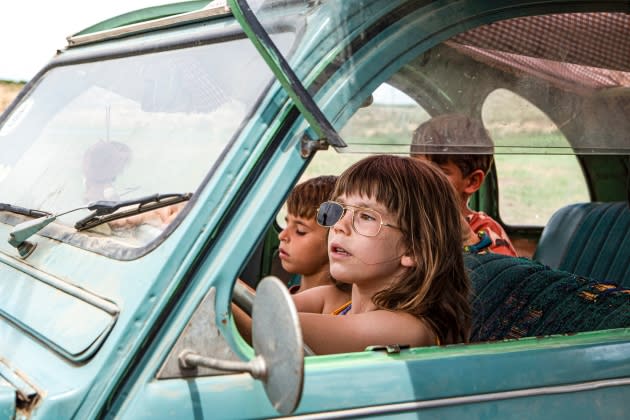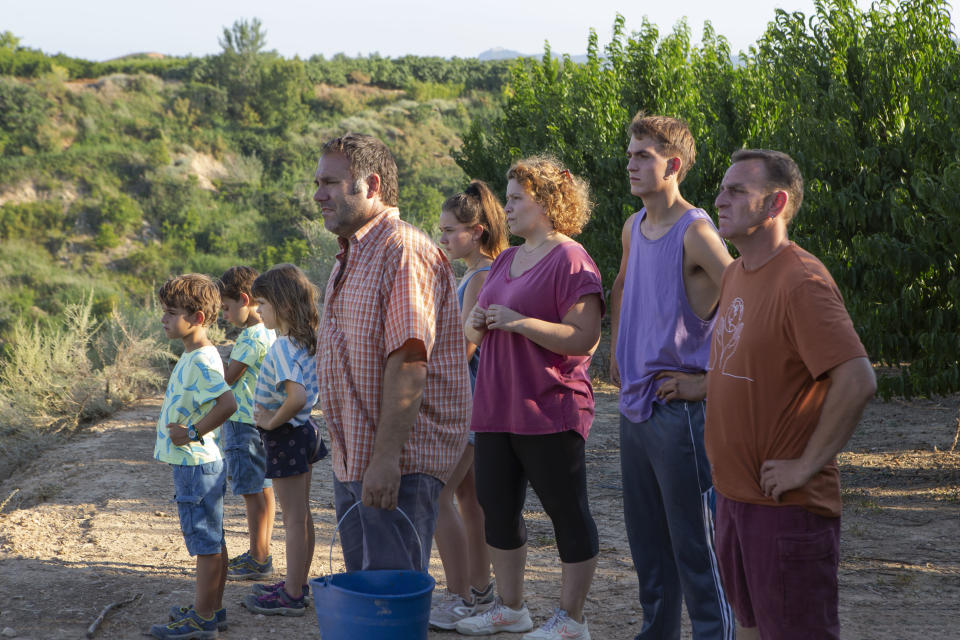‘Alcarras’ Is a Powerful Movie About a Divided Family Fighting for Its Future

Carla Simón’s wonderful Alcarràs is set in Alcarràs, Catalonia, among a three-generation family of peach farmers whose future is uncertain. The movie is about this uncertainty. Years ago, the patriarch of the family, Rogelio (Josep Abad), made a deal with the owners of the land, the Pinyols, that it now belonged to his family. There was no written contract, only an agreement — a promise that Pinyol’s son, who now runs things, has no legal obligation to honor. Rogelio had no reason to doubt that the Pinyol family would keep its word.
As is so often the case in a story like this, there is history between these two families. Rogelio’s family long ago sheltered the landowners in wartime, when the Pinyols were targets precisely because they held land. Built into the agreement between these two families, we sense, was an understanding that something was owed — that honor was at stake in the agreement. When we meet Rogelio’s clan in Alcarràs, the violation is already underway. Pinyol’s son wants to build solar panels on the property — property which, so far as he is concerned, still belongs to his family. He wants Rogelio’s family to shift from peach farming to working with him to maintain this imminent solar farm. He wants, in effect, for their entire way of life to change — for them to modernize, and with them, the West Catalonian countryside that Simón’s movie carefully, thoroughly depicts.
More from Rolling Stone
Solar Power: The Best Portable Panels for Road Trips and Beyond
RS Recommends: The Best Portable Power Stations for On-the-Go Charging
Alcarràs is a movie about the future. It is not a thriller, but it hinges on just as urgent a central conflict: The basic question of what this family will choose and what will happen to the unit either way. The movie encourages us to perceive something of that future by diving fully into the present. This isn’t only because of the incumbent solar panels, but they matter too: We look on, right at the family’s side, as Pinyol’s workers begin constructing them in the distance, and as they grow more populous throughout the movie. We watch as Rogelio’s son Quimet (Jordi Pujol Dolcet), who runs the farm now, talks to other farmers about potential protests, worries himself sick over unfair market prices, works himself ragged, tightens his reins on the family as they enter what could be their last season of harvest. Holding everyone together becomes his second occupation. Farming as a family remains the first.
Three generations of family emerge throughout Simón’s smart and sensitively sculpted script (written with Arnau Vilaró), each with its own alliances and concerns and divisions. At the top is Rogelio, followed by his son Quimet. At the bottom are the young people. There are two older teens, Mariona (Xènia Roset) and Roger (Albert Bosch), who are the children of Quimet and his wife Dolors (Anna Otin), and below them, a gaggle of playful younger cousins, including their younger sister Iris. Aunts and an uncle populate the margins. And beyond the immediate family, there are Black workers — for as long as the family can still afford to hire them — and occasional friends.
The family is what matters most to the movie. Simón is attentive to the family as a complex unit, depicting it as a thriving mesh of personalities that do not all agree, but which are all bent toward the common ends of labor and survival, like the fibers comprising a muscle. For a while, it’s the differences that seem to hold them together. It allows the family to somehow feel more coherent, with everyone occupying their role. The youngest kids spend much of the movie off on their own, on the land, playing, dreaming, getting into trouble. The teens, meanwhile, are on the precipice — they have lives beyond the family, but as times get tougher, they pitch in more, work more. There’s immediate poignancy in this, evidence that they love this farm as much as their elders, even if they seem to have a chance to be less tied to it. Maybe Quimet, who keeps encouraging Roger to focus on school, wants them to start severing those ties — maybe he already knows that their current life cannot be sustained and wants his kids to have a chance to make something else of themselves. But he loves the farm, too, and wants it to survive. When the rest of the family tries to pitch in more labor, he doesn’t stop them.
Simón favors a naturalistic style, down to her use of non-professional actors (not that you can tell that they aren’t professionals: the performances here astonish because they have the kind of charismatic realism and inherent watchability that feels right at home in a movie such as this). The subtlety of her filmmaking is largely a matter of rhythm — there’s an emotional cadence to the way she constructs her scenes, where casual moments might get heightened by, say, the sound of adults arguing in another room, or by recognition of a minor betrayal, or by Quimet’s sudden frustration.
Simón refuses to allow Alcarràs to settle for being just one thing; she drifts between her characters’ moods with rare realism. Conversation at the dinner table shifts from mundane to tense at the mention of the solar panels. A son and daughter may act out at their father in annoyance, only for Simón’s drama to show us how loyalty to the family, and to their father, pulls them back into the fold. Look at her handling of the character of Quimet, alone. It would almost have been easier for Quimet’s worries to so overwhelm him that it cast a shadow over not only his personality, but the family under his thumb. But Simón instead gives us a man who, when he isn’t worrying about the future, throws his kids into the pool, and smokes his son’s weed (which he isn’t supposed to know about). He rails against his family in one moment, embraces them the next. The dramatic ebb allows Simón’s gift for observation to slowly nudge new concerns to the forefront — such as the women of the story, who do not start out as the film’s focus and yet have their own ideas about the future, as well a measure of indirect influence over the fate of the family. It’s one of those complications that Simón wields to show us a family that’s less unified than we at first imagined. At first, our ability to sort the family out into various camps of age-peers, or people of the same gender, or whatever else, only makes the family feel coherent. Eventually these divisions feel like the opposite, like something more stark. The family, it turns out, does not agree about what it should do. They agree on the present — there is a harvest to take care of — but not on what their lives may hold beyond the end of this fateful summer.

In its own stealthy way, Alcarràs situates itself among the people who’ll remember this moment long into the future — the teens and the youngsters — and to the people whose own memories of this place are what make it worth preserving: the elders. These are the faces we seem to watch the most, looking on as the teens sop up and overhear conversations among the adults or steal away to think about their own lives and futures, and studying the elder Rogelio as he walks his property with a stoic face that nevertheless implies the grief of constant reminiscence.
The youngest children, meanwhile, gently anchor the movie in a sense of habit. Alcarràs tracks the onslaught of change by steeping us in a way of life that is so palpable we can sense the gravity of its minute shifts — and that begins with the children. We open with a scene of play: the three tiny cousins, each an adorable little troublemaker, playing in an abandoned turquoise car at the outskirts of the property, only to be yelled at by a worker from outside who’s come to take that car away. Without the car, they spend the rest of the movie finding other things, like the worker’s pallets, to transform with their imaginations. They are emblematic of the family as a whole. When conflict breaks people apart, it’s the dissolution of this young trio that Simón brings to our attention: a rift in the family summed up in the lost looks of three kids who can no longer play with each other. A future summed up, in the movie’s closing images, by a bulldozer that’s begun to tear through a landscape that had defined their childhoods.
It’s all in the ending. In one moment, Quimet and the other local farmers are protesting their fate. In the next, we see the family reemerge as a full unit again, handling the season’s peaches. But in the background of that scene is a sound, a motorized destruction that can only mean one thing. It is very close to their house, and a signal of how far the family got in this fight. It’s to Simón’s great credit that we cannot rightly predict what will happen next. All along, we were allowed to think that the fate of this family’s farm was in question — that the family was so tied to the land that the destruction would in some way be mutual. But it’s the family itself, not the farm, whose future we could not properly see. What happens to the farm feels like a foregone conclusion, in the end. That’s the tragedy of it. Everyone here, including us, already saw it coming.
Best of Rolling Stone

